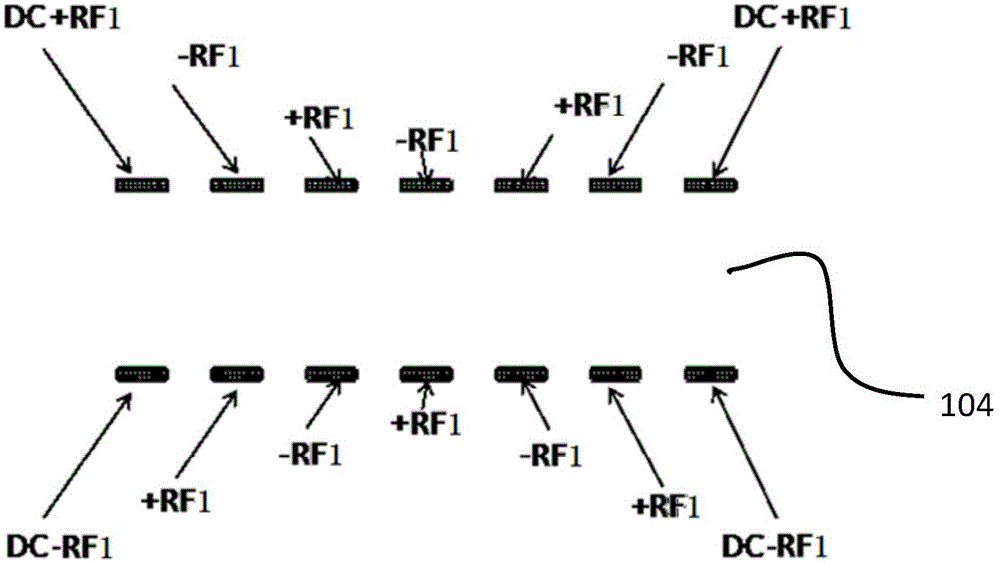Ion guiding apparatus
An ion guidance and ion technology, applied in the direction of measuring devices, particle separation tubes, sample introduction/extraction, etc., can solve the problems of complicated circuit connection, high power consumption, inconvenient processing, etc., and achieve simple electrode shape and device structure, reduce Interference, the effect of facilitating processing and assembly
- Summary
- Abstract
- Description
- Claims
- Application Information
AI Technical Summary
Problems solved by technology
Method used
Image
Examples
Embodiment 1
[0090] like figure 1 Shown is a schematic structural view of the best embodiment of the ion guide device of the present invention. As shown in the figure, the ion guide device 10 includes two sets of plate electrodes 101 a and 101 b extending along the spatial axis 102 , a first power supply device and a second power supply device. The two groups of plate electrodes 101a and 101b are extended and arranged in a direction perpendicular to the space axis 102, and at least one surface of each electrode 103 in each group of plate electrodes is basically on the same space plane, and the two groups The space planes where the plate electrodes 101a and 101b are located are not the same space plane and are not parallel, that is, there is an angle other than 180 degrees between the two space planes, so that the cross-sectional area in the direction perpendicular to the space axis 102 gradually decreases ion transport channels. The ion inlet 104 of the ion transmission channel has a lar...
Embodiment 2
[0106] Figure 13 Shown is another embodiment of the ion guide device of the present invention, which is used to further enhance the effect of the axial osmotic potential gradient. In this configuration, a set of auxiliary electrodes 108 are placed on either side of the ion guide. The second power supply device applies a voltage signal to the auxiliary electrode. By applying a voltage on it to limit the movement of ions to both sides, and at the same time establish an axial osmotic potential gradient inside the ion channel to drive ion transport. It should be noted that, in this embodiment, the second power supply device optionally applies voltage signals to the two groups of electrodes. The advantage of this structure is that the auxiliary electrode has a larger coverage area, so a stronger potential gradient can penetrate into the ion guide from both sides, thereby reducing the residence time of ions. In addition, when the auxiliary electrode 108 is not parallel to the sp...
Embodiment 3
[0108] and figure 1 The difference between the two groups of electrodes shown in the horizontal parallel expansion arrangement is that, as Figure 15 As shown, another embodiment of the ion guide device of the present invention also includes a device with a non-parallel expansion arrangement structure in the lateral expansion direction. The electrode system of the ion guide device is not a parallel structure in the lateral direction, but gradually approaches the central axis from both sides starting from the ion entrance. The benefit of this embodiment is that a relatively small number of electrodes can be used while allowing for a large ion receiving area and a small and focused ion outlet. In addition, the middle two groups of electrodes can essentially form a quadrupole structure with a gradually decreasing field radius, so it can always maintain a better focusing effect of ions, especially in the area near the ion entrance, which can reduce ion loss to a certain extent ....
PUM
 Login to View More
Login to View More Abstract
Description
Claims
Application Information
 Login to View More
Login to View More - R&D
- Intellectual Property
- Life Sciences
- Materials
- Tech Scout
- Unparalleled Data Quality
- Higher Quality Content
- 60% Fewer Hallucinations
Browse by: Latest US Patents, China's latest patents, Technical Efficacy Thesaurus, Application Domain, Technology Topic, Popular Technical Reports.
© 2025 PatSnap. All rights reserved.Legal|Privacy policy|Modern Slavery Act Transparency Statement|Sitemap|About US| Contact US: help@patsnap.com



